Return of the Fairey Ultra-Light, G-AOUJ / XJ928
| The Museum's
Fairey Ultra Light, G-AOUJ / XJ928, c/n F9424, returned home on
3rd November 2010 after having been with the Cotswolds Aircraft
Restoration Group since the mid-1990s. The machine is one of four
prototypes which were built by Fairey Aviation Ltd in Hayes, Middlesex,
in 1954/55, in response to British Army requirements for an air
observation platform. XJ928 was the second prototype, making its
first flight, from White Waltham, on 20th March 1956. Just before this first flight the Ministry of Supply decided to withdraw their support, leaving the Army reliant on the contemporary Saunders-Roe Skeeter. Fairey however, continued to build a further two Ultra-Lights as a private venture development. After the Ministry cancellation, hydraulically powered cyclic controls and a modified cabin were fitted to XJ928 and it was registered G-AOUJ in August 1956. The modified cabin was designed for emergency freight transport and allowed a stretcher to be loaded diagonally alongside the pilot. It flew for the first time with the modifications incorporated, in September 1957. One or both of the Ultra-Lights, G-AOUJ and G-AOUK, appeared at the SBAC Exhibitions and Displays at Farnborough in the years 1955-58, taking off from, and landing on, a moving Army 3-ton flat bed truck. Spectators were especially impressed by their agility, rapid climb rate and fast, precipitate, descents in autorotation. |
 Fairey Ultra-Light, G-AOUJ, at The Helicopter Museum in 1991. Thanks to Derek Heley, Air-Britain Images, for permission to use this photograph. |
|
 Fairey Ultra-Light, G-AOUJ, at Gloucestershire Airport in June 2007. Thanks to Dave Haines, www.flygloster.co.uk, for permission to use his photograph. |
||
The British Admiralty expressed interest in the ULH as a potential light, frigate-borne, anti-submarine helicopter and G-AOUJ carried out Royal Navy evaluation trials from a platform on the deck of HMS Grenville at sea in 1957. Further sea trials with an Ultra-Light were conducted in 1958 from HMS Undaunted but, with the Saunders-Roe P.531 prototype (leading to the Westland Wasp), showing promise, Navy interest in the Ultra-Light ended in 1959. Fairey abandoned the project before their aircraft manufacturing business was acquired by Westland in 1960. G-AOUJ, partially dismantled, with blades, engine and rotorhead removed, was sent from White Waltham to a scrap yard, in 1969, with its registration lapsed and with documentation declaring its destruction. Soon afterwards Mr Peter Swettenham, an enthusiast, acquired the surviving airframe from the scrap yard and moved it to a farmhouse near Harlow, Essex, intending to restore it. Very little work was done and the machine deteriorated in open storage. |
||
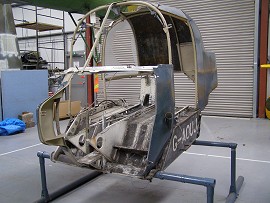 Fairey Ultra-Light, G-AOUJ, soon after its return to The Museum on 3rd November 2010. |
Elfan ap Rees,
founder and current chairman of The Helicopter Museum, became aware
of an opportunity to acquire the aircraft which was duly transported
to Weston-super-Mare in May 1979, where it was put into temporary
storage to await restoration. Rotor blades, an engine and an instrument
panel were later obtained from Cranfield and elsewhere but no rotorhead
could be found then or since. By 1991 G-AOUJ had been partially re-assembled by Museum volunteers, although it still lacked a rotorhead. Partly due to a heavy workload and shortage of covered space at The Museum, the Ultra-Light was loaned to the Cotswold Aircraft Restoration Group, in Gloucestershire, so that restoration could continue there. Some valuable work was being done until closure of RAF Innsworth was announced and CARG's workshop had to be re-located to Quedgeley in 2002. After another enforced move in 2007, Peter Turner, a Helicopter Museum trustee, offered suitable temporary hangar storage for G-AOUJ, at Gloucestershire Airport, until it was returned to The Helicopter Museum, at Weston-super-Mare, in November 2010. |
|
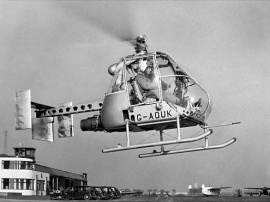 Fairey Ultra-Light, G-AOUK / XJ924, was shown at Farnborough in 1956 and continued to be used afterwards, primarily, as a demonstrator. |
The Ultra-Light
was a compact, side-by-side, two-seater helicopter with an enclosed
cockpit mounted on a strong alloy box which contained the fuel tank
bag. The two crew seats, with pilot on the right and observer (optionally
facing aft) on the left, were fixed on top of the box. Also attached to the box was a rectangular-section tail boom which supported a Blackburn-Turbomeca Palouste turbine, with oversized compressor, behind the seats. Further to the rear a central rudder was positioned in the turbine efflux, for yaw control. A horizontal tailplane with endplate fins (see left) was added to later versions. A pair of skids were attached to tubes across the underside of the box. The Palouste compressor fed air through ducts to the blade ends where fuel was injected and the mixture ignited before being directed to the blade tip jets. |
|
| Cockpit controls were orthodox with a collective pitch lever for adjusting engine revolutions, hence tip jet pressure, and a cyclic stick for roll and pitch control. | ||
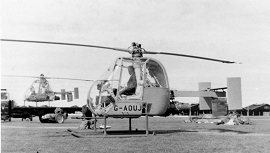 |
It was thought desirable that work on the rebuilding of G-AOUJ, at The Helicopter Museum, should be completed before the end of 2012. To avoid diverting effort away from current helicopter restoration and conservation projects a small team of three new volunteers, with previous aviation experience, was recruited. Early in February 2011 they started on the task of identifying the many separate components which had arrived three months previously. | |
| The three volunteers are still hoping to contact anyone with first-hand experience of the Ultra-Light, maybe at Hayes or White Waltham, in the 1950s. | ||
| Fairey
Ultra-Light, G-AOUJ, seen at Farnborough in 1957, painted yellow
with black lettering. G-AOUK is in the background, on an Army truck. |
They have visited the Midland Air Museum, at Coventry Airport, three times. MAM holds the only surviving complete Ultra-Light, G-APJJ, the last to be built (below). | |
 |
 |
|
| Fairey Ultra-Light G-APJJ displayed at the Midland Air Museum, Coventry. Thanks to Simon Palmer for the above two photographs. | ||
 |
 |
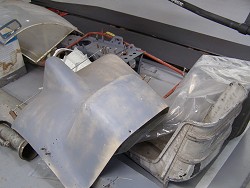 |
||
| An example of a Palouste turbine but not from a Fairey Ultra-Light. | Opposite ends of G-AOUJ's two rotor blades, showing a tip jet. | Some of G-AOUJ's components which have returned to The Museum. | ||
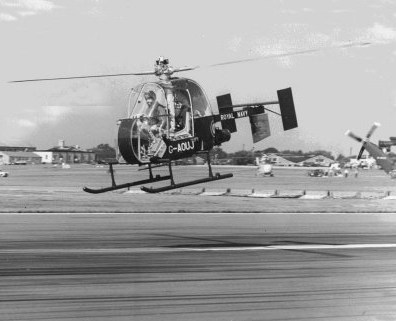 |
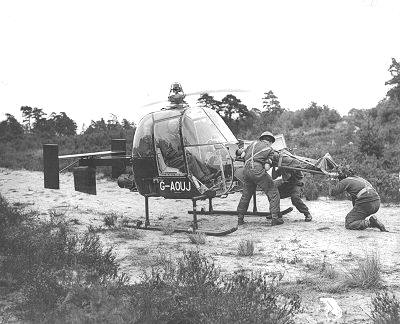 |
|
| Ultra-Light G-AOUJ, in Royal Navy scheme, displayed at the 1958 Farnborough Show with Fairey test pilot Lt.Cdr John G.P. Morton OBE at the controls. Earlier in 1958 Morton flew trials of G-AOUJ, in Arctic conditions, in Canada. | G-AOUJ, modified to carry a front-loading stretcher and flown by Peter Twiss, Fairey Aviation test pilot from 1946 to 1960, took part in a nuclear war casualty evacuation exercise, near Aldershot, with the RAMC in October 1958. |